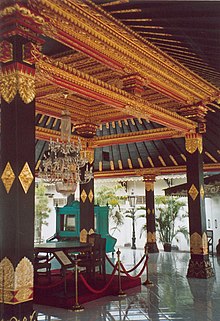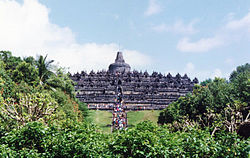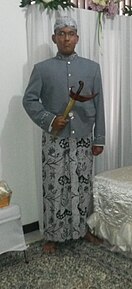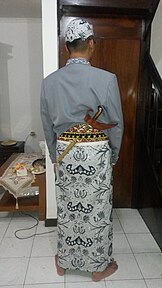Javanese culture

Javanese culture (Javanese: ꦏꦧꦸꦢꦪꦤ꧀ꦗꦮ, romanized: Kabudayan Jawa) is the culture of the Javanese people. Javanese culture is centered in the provinces of Central Java, Yogyakarta and East Java in Indonesia. Due to various migrations, it can also be found in other parts of the world, such as Suriname (where 15% of the population are of Javanese descent), the broader Indonesian archipelago region,[1] Cape Malay,[2] Malaysia, Singapore, Netherlands and other countries. The migrants bring with them various aspects of Javanese cultures such as Gamelan music, traditional dances[3] and art of Wayang kulit shadow play.[4]
The migration of Javanese people westward has created the coastal Javanese culture that is distinct from inland Sundanese culture in West Java and Banten. Being the largest ethnic group, the Javanese culture and people influence Indonesian politics and culture, a process sometimes described as Javanisation.
Literature

During the reign of Majapahit several notable works was produced. Nagarakretagama describes Majapahit during its height. Tantu Pagelaran explained the mythical origin of the island and its volcanic nature. Kakawin Sutasoma, written by Mpu Tantular during the reign of the Majapahit. It is the source of the motto of Indonesia, Bhinneka Tunggal Ika, which is usually translated as Unity in Diversity, although literally it means '(Although) in pieces, yet One'. The kakawin teaches religious tolerance, specifically between the Hindu and Buddhist religions.[5]
Other works includes
Spirituality
| Part of a series on |
| Religion of Java |
|---|
 |
Religion
Majapahit empire
Historically, Javanese follow a syncretic form of Hinduism, Buddhism and
Starting from the 15th century, Islam and Christianity came to Java and slowly spread. Due to internal and external conflicts, Majapahit collapsed in the 16th century. Islam spread quickly under the new Islamic monarchs. While the spread of Christianity was supervised by colonial powers.
All the new religions were not taken literally but instead interpreted by the Javanese according to the Javanese traditional values, creating a new set of religious beliefs unique to local culture.
Islam
Islam first came in contact with Java during Majapahit periods, when they traded or made tributary relations with various states like Perlak and
The introduction of Islam to the island by the new Muslim monarchs was not always peaceful however, Javanese nobles and peasants who rejected the new rulers were either conquered or fled to neighboring
Christianity
A minority of Javanese also follow
Hindu-Buddhist
Another minority are Hindus and Buddhists, they are mostly found in East Java (also some in parts of Central Java and Yogyakarta). The Javanese Tengger tribe is still practicing Javanese-Hindu until today.[10] There are also many new recent converts of Javanese to Hinduism and Buddhism.
Kebatinan
Kebatinan are principles embodying a search for the inner self but at the core is the concept of the peace of mind, connection with the universe, and with an Almighty God. Although Kebatinan is not strictly a religious affiliation, it addresses ethical and spiritual values as inspired by Javanese tradition. It is not a religion in usual sense of the word, like
Ceremonies
Many traditional Javanese customs or festivals such as meditation,
Grebeg Maulud

Grebeg Maulud is a traditional ceremony held by the royal court of Keraton Surakarta and Jogjakarta, to commemorate the birth of Islam's holy messenger, Muhammad. This ceremony was first held during the reign of the Demak Dynasty dating back to the 15th century. The ceremony starts with prayers in the grand mosques, a parade and a carnival of the people.
Javanese wedding
There are several variations of Javanese wedding, depending on the custom and social standing of the couple. Popular variation includes Surakartan, Jogjakarta, Paes Kesatrian, and Paes Ageng. The wedding rituals will include Siraman, Midodareni, Peningsetan, Ijab (for Muslims) or wedding sacrament (for Christians).
Siraman
The bride and groom to be are showered at their respective homes, by families and close friends. Prayers are also given hoping for a good tide.
Midodareni
Naloni Mitoni
Held for the first pregnancy of a woman, when the pregnancy is in its seventh month. Family and close friends are invited. The mother-to-be is shrouded with seven layers of batik, symbolizing hope for a good child and delivery. Prayers and traditional food are also served.
Selapanan
Held when a child is 35 days, a ritual celebrating the new life. Family members and close friends will come to the event. The child's hair and nails are shaved. prayers, religious readings and a slametan is a common part of the event. After the event, cakes, sweets and eggs (symbolising the new life) will be shared.
Tedhak Sithen
Held when a child is around eight months old. Family members are invited, to celebrate a child starts walking.
Khitan
For a boy, khitan, or circumcision, is an important transition toward adulthood. The ritual usually held when the boy is 6 to 12 years old. Following the circumcision it is customary to sacrifice a goat, hold a slametan and wayang kulit (shadow puppet) performance.[11] Circumcision is one factor that differentiate the Javanese with related Balinese and Tenggerese, which still predominantly Hindu.
Ruwatan Gembel
The day Hindu children of the Dieng community shave their hair. A large offering ceremony to the Gods at the temples are given. Afterwards the community arranges a festival. Tourists normally flock to see the event.
Slametan
Prayers to hope for good tidings. Normally tumpeng is served.
Patangpuluhdinanan, Nyatus, Nyewu
Prayers given on the 40th, 100th, and 1000th days since a person deceased.
Nyekar
Before the month of Ramadhan, family members visit the graves of their loved ones, pray for their well-being.
Labuan
A kejawen ceremony, where
Social structure

The
But today the Geertz opinion is often opposed because he mixed the social groups with belief groups. It was also difficult to apply this social categorisation in classing outsiders, for example other non-
Social stratification is much less rigid in northern coast area, which is much more egalitarian.
Sultans
The Keratons, the royal palaces of the Yogyakarta Sultanate and the Surakarta Sunanate, are the central of the Javanese culture and social events. Although they are not ruling monarchs, they are still highly revered and look upon in the society. When addressing to the Sultan, a person is expected to speak in the refined "kromo inggil", but today formal bahasa Indonesia is also accepted.
Not all Javanese were once subjects of the Yogyakarta Sultanate and the Surakarta Sunanate.
Priyayi
The Priyayis were once part of the ruling aristocrats, they have little function today. Some of Indonesia's ruling political figures are descendants of the priyayis. They are now part of the general society and work in numerous fields.
Villages
Villages are an important administrative unit in Java. It is divided into two types: Desa with elective leadership, usually in rural areas, and Kelurahan, where the leadership is appointed by Indonesian government, usually in urban areas. Village administration is managed by officers, still called with their traditional Javanese names. These are lurah (village chief), assisted by offices of carik (village secretary), kamituwa (officer for social affairs), jagabaya (officer for security), and modin (office for Islamic affairs and rituals, derived from Arabic Imam ad-Din, or leader of the faith).[13]
These officers traditionally didn't get paid in cash, but allotted a portion in the village's public land to be farmed, called tanah bengkok.[13] In modern-day Indonesia, Village chief is elected directly by universal suffrage of the villagers, who are 17 years old and above, or already married.[14] As literacy rate was low before independence, it is customary for the rival candidates to use common items as their campaign symbol, such as fruits, vegetables or traditional foods. The village chief election is usually non-partisan.
Family
Culturally, Javanese people adopt a
In a traditional marriage, it is the groom's family who chooses the bride from a selection of prospects. Prior to the wedding, the groom's family will give the bride's family a sum of dower. Afterwards, the bride's family is responsible for paying for the wedding. The groom's family can help financially, but they are not obliged to do so. Traditionally, divorce is not acceptable, but it was acceptable for the husband to take a second wife or a mistress. Young Javanese normally do not follow these customs, and today most Javanese women will resist infidelity and opt for a divorce. Divorce is becoming acceptable in Java.[17]
-
Javanese Surakarta bride in dhodot or Solo basahan royal wedding costume.
-
Picture of Javanese lady in traditional dress
Language
Javanese is a member of the Austronesian family of languages and is closely related to, but distinct from, other languages of Indonesia.[18] It is notable for its great number of nearly ubiquitous Sanskrit loans, found especially in literary Javanese.[19] This is due to the long history of Hindu and Buddhist influences in Java.
Most Javanese in Indonesia are
The Javanese language was commonly written with a script descended from the Brahmi script, natively known as Hanacaraka or Carakan. Upon Indonesian independence it was replaced with a form of the Latin alphabet.
While Javanese was not made an official language of Indonesia, it has the status of 'regional language' for communication in the Javanese-majority regions. The language also can be viewed as an 'ethnic language' because it is one of the defining characteristics of the Javanese ethnic identity.[18]
Occupations
In Indonesia, Javanese can be found in all occupations, especially in the government and the military.
Farming
Traditionally, most Javanese are farmers. This was especially common because of the fertile volcanic soil in Java. The most important agricultural commodity is rice. In 1997, it was estimated that Java produced 55% of Indonesian output of the crop.[21] Most farmers work small-scale rice field, with around 42% of farmers cultivate less than 0.5 hectare of rice field.[21] In region where soil is less fertile of where rainy season is short, other staple crops is cultivated, such as cassava.[22]
Blacksmithing

For the Javanese, blacksmiths are traditionally valued. Some blacksmiths fast, and meditate to reach perfection. Javanese blacksmiths provide a range of tools such as farming equipment and to cultural items such as gamelan instruments and kris.[22] Majapahit rigidly use fire-arms and cannonade as a feature of warfare. The Javanese bronze breech-loaded swivel-gun, more correctly known as a meriam was used ubiquitously by the Majapahit navy and unfortunately pirates and rival lords. The demise of the Majapahit empire also cause the flight of disaffected skilled bronze cannon-smiths to Brunei, modern Sumatra and Malaysia, and the Philippines lead to near universal use of the swivel-gun, especially on trade vessels to protect against prevalent marauding pirates, in the Makassar Strait.[23]
Keris is an important item, with many heirloom kris made by master blacksmiths holding significant historical value. The design of the keris, with its snake like blade, is to tear apart an opponent's abdomen, making the injury more severe. While the Javanese canting, enables them to make intricate Batik.
Batik
Batik textiles are a traditional pastime for women, although some villages specialize in batik, such as Pekalongan, Kauman, Kampung Taman, and Laweyan.
Wood carving

The Javanese art of wood carving is traditionally applied to various cultural attributes such as statues, (wayang-)dolls, and masks.
Calendar
The Javanese
Unlike many other calendars, the Javanese calendar uses a 5-day week known as the Pasaran cycle. This is still in use today and superimposed with 7-day week of the Gregorian calendar and Islamic calendar to become what is known as the 35-day Wetonan cycle.
Art
Javanese origin artforms are among the best known in Indonesia and the whole archipelago. The famous Javanese wayang puppetry culture was influenced by Hindu and Buddhist traditions. The Wayang repertoire stories, lakon, are mostly based on epics from India; Ramayana and Mahabharata. These epics and stories influenced wayang puppetry as well as Javanese classical dances. The influences from Islam and the Western world also can be found. The art of batik, and kris dagger are of Javanese origin.
Music
Architecture

Throughout their long history, the Javanese have produced many important buildings, ranging from Hindu monuments, Buddhist stupa, mortuary temples, palace complexes, and mosques.
The paragon of religious monuments are Hindu temple of Prambanan and Buddhist temple of Borobudur. Both of them 9th centuries temples which are UNESCO World Heritage Site. Both are located near city of Yogyakarta in the slope of Mount Merapi.
Meanwhile, example of secular building can be seen in ruins of former capital city of
Traditional Javanese building can be identified by its trapezoid shaped roof supported by wooden pillars.
Traditional mosques in Java maintain a distinctive Javanese style. The pendopo model is used as main feature of the mosque as its prayer hall. A trapezoidal roof is used instead of the more typically Muslim dome. These roofs are often multi-tiered and tiled.[28] In addition to not using domes, traditional Javanese mosques also often lack minarets.[29] The split gate from earlier Hindu-Buddhist period is still used in many mosques and public buildings in Java.
Some notable examples of mosques using traditional Javanese architecture include
Names
Javanese do not usually have family names or surnames. Many have just a single name, such as
names followed by a traditional Javanese name.Some people use a
Cuisine


Javanese cuisine and culture place an important role in
Javanese cuisine is varied by regions. Eastern Javanese cuisine has preference for more salty and hot foods,[31] while the Central Javanese prefer sweeter foods.
Famous food in Javanese cuisine is for example
Tumpeng, is a rice served in the shape of a conical volcano,[36] usually with rice colored yellow using turmeric. It is an important part of ceremony in Java. Tumpeng served in landmark events such as birthday, moving house, or other ceremonies.[37] Traditionally, Tumpeng is served alongside fried chicken, boiled egg, vegetables, goat meat on a round plate made from bamboo called besek.
A notable food in Java is
See also
- Dewi Sri
- Nyai Roro Kidul
- Javanese Kshatriya
- Javanization
- List of Javanese people
- Javanese in Singapore
- Javanese Surinamese
Further reading
- Koentjaraningrat. (1985). Javanese culture. Singapore: Oxford University Press.
Notes
- ^ Shucker, M. A. M. (1986). Muslims of Sri Lanka: avenues to antiquity. Jamiah Naleemia Inst.
- ISBN 978-1-86825-560-3.
- ISBN 978-0-7546-0831-8.
- ISBN 978-0-7864-4838-8.
- ^ a b "Departemen Hukum dan Hak Asasi Manusia Republik Indonesia - UUD 1945 - UUD 1945". Archived from the original on 2010-02-12. Retrieved 2011-06-09.
- ISBN 978-90-0413561-1.
- ^ "Javanese Religion".
- ISBN 978-1-920942-31-1.
- ^ "WALISONGO".
- ISBN 978-0-521-62473-2.
- ISBN 978-979-378051-1.
- ISBN 0-00-635721-0.
- ^ ISBN 978-0-7007-0295-4.
- ^ "Proses Pemilihan Kepala Desa Dalam Rangka Pelaksanaan Democracy". Archived from the original on 2012-03-12. Retrieved 2012-05-28.
- ISBN 978-0-87546-162-5.
- ^ ISBN 978-1-56324-890-0.
- ISBN 978-0-226-28510-8.
- ^ ISBN 978-0-7946-0000-6.
- ISBN 978-9971-988-39-5.
- ISBN 978-0-521-63448-9.
- ^ ISBN 978-0-7007-1465-0.
- ^ ISBN 978-0-8223-4687-6.
- ISBN 0-19-580347-7, 1088 pages.
- ^ Tadié, J (1998), Guillaud, Dominique; Seysset, M.; Walter, Annie (eds.), Kota Gede : le devenir identitaire d'un quartier périphérique historique de Yogyakarta (Indonésie); Le voyage inachevé... à Joël Bonnemaison, ORSTOM, archived from the original on 9 August 2020, retrieved 20 April 2012
- ^ Ministry of Culture and Tourism of the Republic of Indonesia (October 6, 2009). "Trowulan - Former Capital City of Majapahit Kingdom". United Nations Educational, Scientific and Cultural Organization (UNESCO) World Heritage Convention.
- ISBN 978-979-969060-9.
- ISBN 978-1-900949-51-4.
- ISBN 9780415236157.
- ISBN 978-81-2610403-1.
- ISBN 978-0-7546-7994-3.
- ^ ISBN 978-1-85359-851-7.
- ISBN 978-979-223923-2.
- ISBN 978-979-006166-8.
- ISBN 978-1-74059-154-6.
- ISBN 978-979-934179-2.
- ISBN 978-1-920942-34-2.
- ISBN 978-0-7112-1273-2.





